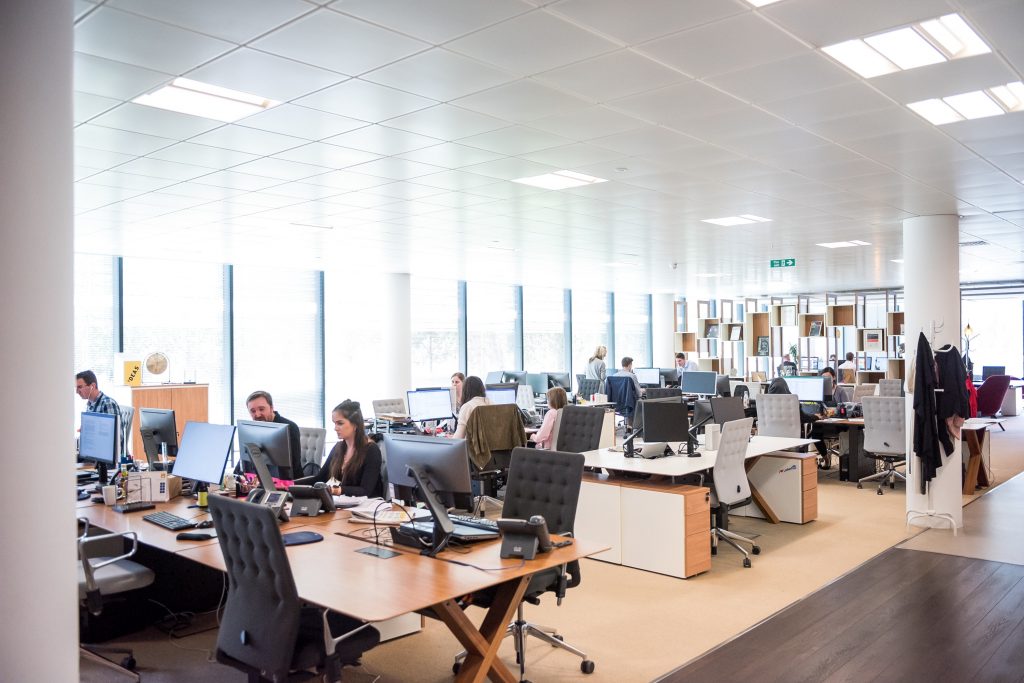In a current Gallup poll, 90% of remote-capable employees prefer some degree of hybrid work flexibility going forward, and 60% specifically prefer hybrid work. It’s here, and it’s the future. Businesses everywhere will need to address the question of how to manage the new hybrid workplace.
We’re hearing constant news of corporations adjusting their return-to-office (RTO) plans and remote work policies, with some extreme responses from employees. Tesla announced in-office work will be mandatory, Facebook and Twitter announced permanent remote work policies, and others like Uber are trying to find a happy medium. Employees are voting with their feet, as they leave or voice their intent to leave workplaces that don’t offer flexible working arrangements.
According to the Gallup Future of Hybrid Work survey, failing to offer flexible work arrangements is a significant risk to an organization’s hiring, employee engagement, performance, well-being and retention strategies.
We’re taking a deep dive into hybrid work: what it is, what it looks like now, what employees are saying about it, pros, cons, and how to make hybrid arrangements work for YOU.
In this article:
Why Companies Choose Hybrid Work
Ways to Take Advantage of Hybrid Work
Choosing a Hybrid Work Schedule

What is Hybrid Working?
A hybrid workplace mixes in-office and remote work. Essentially, it is the idea that employees will either be remote, in-office, or a mix of the two. Companies that label themselves as hybrid have intentionally built their workplace model, with clarity and specificity about how they will function. Hybrid teams allow employees to control their hours and support employees in having a better work-life balance.
We like the way Cisco puts it:
“Hybrid Work is an approach that designs the work experience around and for the worker, wherever they are.”
The hybrid work model is all about flexibility and choice for employees. Each employee is empowered to work in ways that meet their individual needs and abilities. Some jobs lend themselves to fully remote work, while other jobs need some in-person interaction or access to office facilities. Hybrid work allows teams to choose the type of working posture that best suits the individual, the work to be done, and the team at large.
Hybrid work can look like:
- Most of the team working from home, with a rotating schedule of 1-2 employees coming into the workplace each day
- Everyone coming into the office except one fully remote employee in another state
- The whole team coming in only on Tuesdays and Thursdays
- Half the team working in office daily, with the other half working remotely
- Allowing every employee to choose where they’ll work each day
- The engineering teams permanently working remotely and the sales team permanently working from the office
- Any other combination that works for your industry, your business, and your employees
What does WFA mean?
WFA is an acronym for “Work from Anywhere.” It’s another way of labeling hybrid work to emphasize the flexible nature of daily work available to employees. A company may add “WFA” to job descriptions and listings, or include it in their perks and benefits.
One distinction between hybrid work and work from anywhere is that you may need more specific clarifications around your permanent address or the state where you work. If you want a nomadic living situation, then a true work from anywhere policy will work best for you.

Hybrid Work Statistics
In 2018, 62% of employees said they worked remotely at least once a month. (Global Workplace Analytics)
Over 80% of employees said hybrid work would make them feel happier, more trusted, more balanced, and more likely to recommend their company to a friend. (Global Workplace Analytics)
Full remote work found 71% of employees working longer hours and 42% experiencing lower life satisfaction. (source)
58% of the American workforce have the opportunity to work remotely. (My Credit Summit)
Pre-pandemic, commuting employees spent 54 hours a year stuck in traffic.
Office occupancy has hovered around 40% for the past two years. (NYT)
A Robin survey of more than 10,000 offices globally found that nearly 20 percent of American office workers are back one day a week, about 10 percent are back two days a week, just five percent are back three days a week, even fewer are back four or five days a week and more than 50 percent do not use the office consistently every week. (NYT)
Wednesday is the most popular day for going into the office, according to data from the workplace security firm Kastle. (NYT)
58% of employees will quit their jobs if not offered flexibility.
3/10 employees would take a 5% paycut to be able to work from home some of the time
9/10 executives predict hybrid to be the future of work (McKinsey)
Diversity, Equality, and Inclusion under Hybrid Work
- Employees with disabilities were 11 percent more likely to prefer a hybrid work model than employees without disabilities.
- More than 70 percent of men and women expressed strong preferences for hybrid work, but nonbinary employees were 14 percent more likely to prefer it.
- LGBQ+ employees were 13 percent more likely to prefer hybrid work than their heterosexual peers.
- Younger employees (18–34 years old) were 59 percent more likely to leave than older ones (55–64 years old).
- Black employees were 14 percent more likely than their White peers.
- LGBQ+ employees were 24 percent more likely to leave than heterosexual ones.
- Women were approximately 10 percent more likely than men, and employees who identify as nonbinary were 18 percent more likely than men and women.
- Employees with disabilities were 14 percent more likely to leave than employees without them.
- 60 percent of our survey respondents working in hybrid models ranked work–life support in the top inclusion practices they want their organizations to improve
- (McKinsey DEI hybrid work survey)
Why Companies Choose Hybrid Work
For some, the move to hybrid work was fraught with concerns (which we’ll cover below). Overall, though, companies are finding it a positive choice that is benefitting their employees AND their bottom line. Studies indicate that hybrid work was preferred by employees, even pre-pandemic, and it’s easy to see why.
“Executives have realized that when attendance isn’t required, and workers aren’t guaranteed to see their teammates, managers have to be creative about articulating what benefit they see in a commute.”
New York Times
Benefits of Hybrid Work
- Competitive Market: 70% of people expect flexible work options post-pandemic (Microsoft survey). This means you’re fighting an uphill battle to retain and attract talent if you’re unable or unwilling to offer hybrid work.
- Increased Postpandemic Connection: Remote work can be isolating for those who live alone, which is upwards of 36 million Americans. Although fully remote employees enjoy their flexibility, four in 10 would give up some of that time at home to have in-person office experiences.
- Decreased Commutes: Not commuting is the number one reason employees cite for wanting hybrid work. Dropping your commute saves time and decreases risk for employees, lowers pollution, and reduces gas and transit costs.
- Reduced Absenteeism: Insteading of taking the full day off for an appointment or low grade family emergency, employees are more likely to log on for a partial or mostly full day of work.
- Larger Hiring Pool: When employees can work remotely, you aren’t constrained to hires within your geographic area. Forty percent of productivity leaders, by contrast, have holistically redesigned their entire hiring process, according to a McKinsey hybrid work survey.
- Decreased Operating Costs: Fewer people working from the office could mean downsizing, fewer snacks & supplies, decreased cleaning & maintenance costs, reduced utilities & equipment purchases, and more.
- Better Focus: Rather than being interrupted by coworkers in their desk clump or being drawn into a NBA draft argument at the drink fridge, employees are better able to control their environments for optimal focus.
Will these benefits work for your company? That remains to be seen. In the next section, we’ll dive into the challenges of hybrid work that your business might encounter.

Challenges of Hybrid Work
Hybrid work hasn’t always been a smooth transition. When the COVID-19 pandemic forced the hands of business owners across the globe, figuring out remote and hybrid work situations became a scramble—and for some it was challenging. Let’s break down some pitfalls you’ll need to anticipate and circumvent.
“For those who have not been in the office regularly yet, we understand that it might seem daunting combined with a sense of comfort that has set in for many to work primarily from home,” says investment bank executive Brian Friedman. “Yet, we strongly believe the negatives of these realities are far outweighed by the magic of being together in person.”
- Not Every Industry: It’s hard to work from home when you’re the head chef of a swanky restaurant. Some industries and some roles require specialized tools or onsite access, making it difficult to allow full hybrid flexibility
- Communication: Keeping everyone on the same page even when they’re on different schedules and in different locations isn’t impossible, but it does take effort. If asynchronous communication harms your productivity, hybrid work will prove difficult. One Microsoft study found that remote/hybrid work lead to “static and siloed” collaboration.
- Connection: Beyond the communication challenges, hybrid and remote work make it more challenging to form those relationships between colleagues. Working from home has many conveniences, but can be incredibly isolating.
- Distance Bias: Employees may be unfairly rewarded for in-office work vs. remote work.
- Racial, Economic, and Gender Disparities: Hybrid work doesn’t affect every employee equally.
- Security: Employees accessing secure work data from home (or anywhere else!) can introduce compromising circumstances. Upgrading your security and procedures to protect clients, the company, AND employees is critical—and can become a significant undertaking.
- Burnout: Employees must be more intentional about their work/life balance, and it can be rough. Employees may find themselves answering emails well past dinner time, or working through lunch because they’re afraid to be away from their computer.
- Different Management Needs: It doesn’t necessarily have to be a challenge, but hybrid work necessitates a change in the way your management leads teams. Managers will need to develop stronger soft skills, such as giving feedback and creating connection.
According to a McKinsey survey, successful hybrid organizations have helped managers lead differently, including creating small connections, increasing empathy, and developing soft skills.
Ways to Take Advantage of Hybrid Work

Chances are your business has already landed on a semi-permanent policy regarding where employees work—and when. Most workplaces have been navigating the remote/hybrid workplace changes for the past two years, but that doesn’t mean we’ve got it all figured out yet. Whether you’re considering a move to hybrid work, you’ve been rocking hybrid work for the past two years, or you’re trying to optimize a WFA policy, here are a few ways you can take advantage of hybrid work.
Decrease office space
Take a closer look at your office space. How much is actually used? How much are you paying per square foot? Could you save money by downsizing to a smaller office space? If you’re locked into a rental agreement or own a larger space than you need, it’s a great time to consider subletting some of the space.
Reward “in-office” days
Some managers have reasonable concerns that hybrid work will de-incentivize coming into the office or that they’ll lose hard-won team camaraderie. An easy fix for this is to reward onsite days. Provide lunch for the team once a month (or even better—once a week) which will make it an easy choice to come in and share time with the team.
Increase Appreciation
Employee recognition needs to be more intentional when you make the jump to hybrid work, but the good news is that it can actually be easier to create meaningful appreciation between colleagues.
Survey respondents indicated that employees recommend that managers “celebrate and amplify employee contributions and create an environment that regularly recognizes such moments. Seek out achievements (such as well-organized events or team members who coached peers) that many traditional reward and recognition systems take for granted.”
There are a variety of ways to stimulate more employee appreciation, such as employee shout out boards or Slack channels, employee awards, presentations of current projects and wins, and recognizing non-work achievements like birthdays, weddings, babies, etc.
Read more: Does Employee Appreciation Actually Work?
Invest in collaborative software & tools
Since we’ve established that hybrid work is the future, now is the time to assess your tech stack and determine if each solution is suiting your needs. Do you need better tools for tracking projects across multiple teams? It may be time to upgrade to premium accounts or additional licenses for the tools you use the most. It’s not just an issue of productivity—but one of keeping your hybrid team in sync.
Thoughtful meetings and team-building exercises
Connection is one of the biggest challenges for hybrid and remote teams. How do you replace that natural rapport that builds when you’re working in the same place every day? Zoom meetings can be great for productivity, but you’re not getting those small, side conversations or team debates over random topics. Team-building will need to be deliberate—and planned.
A notable finding is that organizations with the biggest productivity increases during the pandemic have supported and encouraged “small moments of engagement” among their employees, moments in which coaching, mentorship, idea sharing, and coworking take place.
McKinsey Survey
Get into the habit of creating detailed agendas that also include opportunities to get to know your colleagues better (a question of the day can be an efficient solution). Plan team-building activities, whether that’s bringing everyone together for a work retreat, or a virtual activity that turns Zoom into an adventure.
Read next: 15+ Effective Team Building Ideas
Ask Your Employees
The very best and most critical piece of advice, though? Ask your employees. Seek constant feedback about how hybrid work is working out for your company. Figure out what they like, what they don’t like, and the problems they’re facing in your current work environment. All the efforts in the world won’t matter for much when your employees feel unhappy and unheard. The fixes might be easy or impossible, but you’re better off knowing—and they’re better off when they have a space for sharing.
“[Sharing personal updates] is a critical way to express care and appreciation for employees as they navigate complex work–life boundaries in hybrid work.”
McKinsey Survey
Choosing a Hybrid Work Schedule
(source)
9/10 Executives see a future of hybrid work, but most have only a high-level plan for execution.
McKinsey Survey
It’s not as simple as saying “come in whenever you want!” Your business will need to carefully determine how, when, and why people want to work the way they do. If someone wants to come in once a month, do they need a dedicated desk or will a coworking space do? What will you do when the entire engineering team needs to come in for a hackathon? Follow these steps to choose a hybrid work schedule that will suit your business needs:
- Gather Feedback. Ask your employees, managers, and even your building staff (cleaning crews, food deliveries, etc.) about their ideal working conditions and schedules.
- Assess Your Space. Do you have the room for everyone to have their own permanent space in the office? How can you create flexible working spaces (hot desks, coworking spots, equipment checkouts)? What will you do if you no longer need most of your space? (Some businesses are relocating closer to the employees who want to work in-office.)
- Outline Parameters. If someone is going to split their time between home and the office, what will that look like? Will they need to schedule or reserve their days in the office? Will it always be Wednesdays? Will everyone need to be in office for the monthly Town Hall meeting?
- Create a System. If someone is going to work some days in the office, they need a way to show the team (and any prospective meeting attendees) where they will be and when. Create a way for employees to reserve open desks and equipment, and organize in-office events on a regular schedule (Mondays only, or always on Tuesday/Thursdays) so employees can begin planning around the new system.
- Iterate. Never assume you’ve reached “perfect.” There’s no such thing when you’re dealing with human resources. Instead, continually seek feedback and tweak your hybrid work schedule to meet changing needs.
Struggling companies are the least likely to iterate, experiment, and redesign their hybrid processes.
Mckinsey Survey
Hybrid Work That Works for You
The hard-and-fast rules we know about hybrid work are this:
- There’s no one “right” way to do it
- Employees demand it
- It must be intentional
- You’ll have to continually tweak it
Hybrid work is well worth the effort, as it demonstrates higher levels of productivity and satisfaction from employees while allowing you to remain competitive and agile. If you’ve been waiting for the right time to optimize your hybrid working model—this is it. We wish you the best of luck with your hybrid workplace!
Sources
- https://www.wrike.com/return-to-work-guide/what-is-hybrid-work-from-home/#:~:text=Hybrid%20work%20refers%20to%20the,spending%20some%20time%20working%20remotely.&text=After%20a%20year%20of%20remote,options%20to%20continue%20post%2Dpandemic.
- https://www.cisco.com/c/en/us/solutions/hybrid-work/what-is-hybrid-work.html
- https://www.gallup.com/workplace/390632/future-hybrid-work-key-questions-answered-data.aspx
- https://porch.com/advice/implement-hybrid-work-model
- https://www.mckinsey.com/business-functions/people-and-organizational-performance/our-insights/its-time-for-leaders-to-get-real-about-hybrid
- https://www.washingtonpost.com/technology/2022/04/05/return-to-office-hybrid-work/
- https://www.forbes.com/sites/jackkelly/2022/05/04/hybrid-work-is-a-recipe-for-disaster/
- https://hr.uw.edu/hybridwork/managing-the-hybrid-workplace/creating-a-successful-hybrid-environment/
- https://www.mckinsey.com/business-functions/people-and-organizational-performance/our-insights/hybrid-work-making-it-fit-with-your-diversity-equity-and-inclusion-strategy
- https://www.qualtrics.com/experience-management/employee/hybrid-work/





